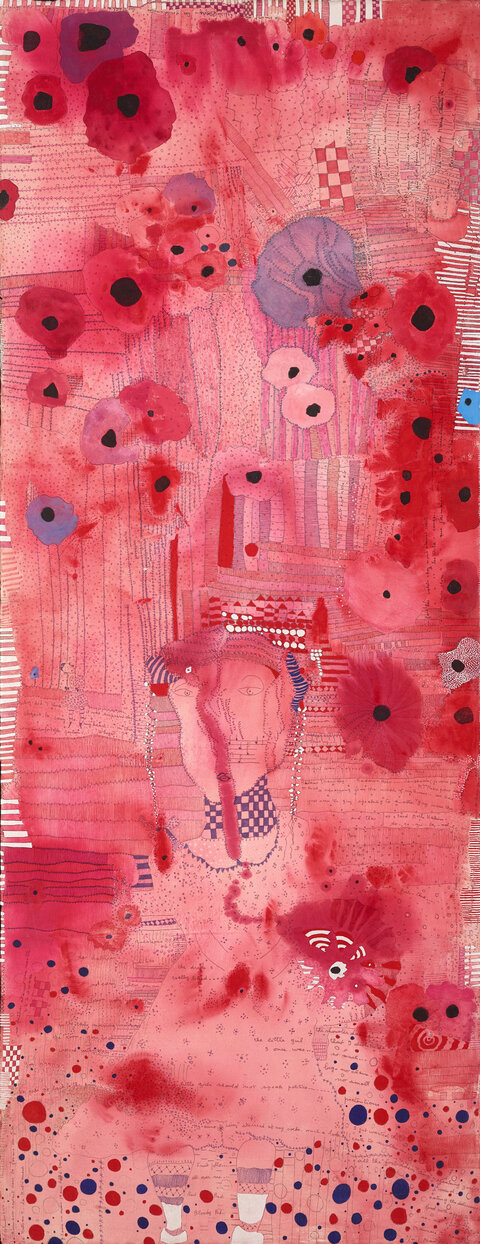Lebanese artist Huguette Caland’s Maison de Freige, 2010, or (House of Freige, 2010) is a deeply personal work that offers a window into her childhood and how it shaped both her artistic style and the themes she would explore throughout her career. Maison de Freige was the home where Caland spent her early years before her family moved to the presidential palace, where her father, Bechara El Khoury, served as Lebanon’s first post-independence president. More than a nostalgic recollection, Maison de Freige embodies the complexity of memory, held together through symbols, emotions, and experiences that shaped the artist’s perception of home and human connection.
The surface of Maison de Freige appears stitched together, much like memory itself: imperfect, fragmented, yet connected. Though the painting is flat, composed primarily of paint and marker on canvas, Caland’s use of X marks and linear shapes creates the illusion of embroidery. These recall the handiwork of her mother, a renowned embroiderer, evoking memories of patience, care, and domestic craft. At the same time, they resemble scars, emphasizing how the past leaves its marks, both physically and emotionally. Through pink, red, and violet poppy anemone flower motifs, and stitching-like symbols, Caland reconstructs moments of her early life, transforming them into a visual language of remembrance and repair. In the lower center of the painting, we notice a fine delineation of a doll-like figure emerging from within the bed of flowers, reminiscent of Huguette as a child.
Caland depicts herself in the painting as a young girl in a frilly dress, her hair wound with pearly jewelry, and her face showing a dull disinterest with what is going on around her. This is placed in sharp contrast with the bright, vibrant, and exciting hues that fill the large canvas, privileging the passion it exudes, potentially reflecting the internal world of this girl over the artificial externality she was forced to or at least expected to project.
Caland inserts handwritten text, in French, that flows playfully throughout the painting’s elongated rectangular composition, reinforcing the work’s deeply personal nature, and mirroring the way memories surface unpredictably. The two phrases that translate to “Lebanon was exploding” and “in the early morning, your room, your bed covered with glass”, directly reference war and instability, a theme that recurs in her recollections of destruction.
Another important theme in Caland’s works is her childhood, which is often referenced. Because of her father’s position, she grew up surrounded by political conversations but overheard phrases like “Little girls should not speak politics”, also written in French onto the painting’s canvas. The tension between restriction and freedom is further expressed in “All the forbidden things… speaking your mind, eating delicious food with appetite… no, no… manners, yes manners.”
This references the comments and criticisms that Caland has faced repeatedly due to her overweight, revealing the struggle between societal expectations, the decorum imposed on someone of her social status, and her own personal desires. It is an exploration of how memory is shaped by relationships and how the past is never static but constantly reassembled. This painting is a deeply personal depiction of where Caland’s rebelliousness originated from and how it has shaped her individuality as she grew up.



-HuguetteCaland-Front.jpg)
-HuguetteCaland-Front.jpg)
-HuguetteCaland-Front.jpg)
-HuguetteCaland-Front.jpg)
-Front.jpg)
-Front.jpg)



